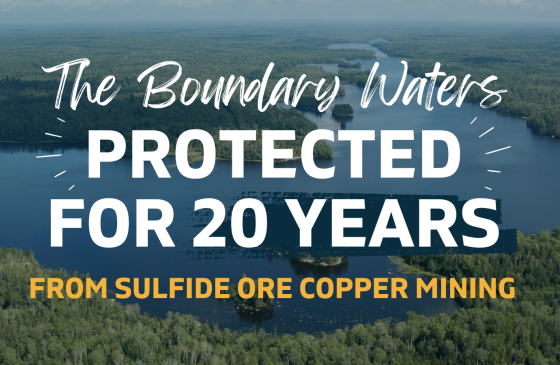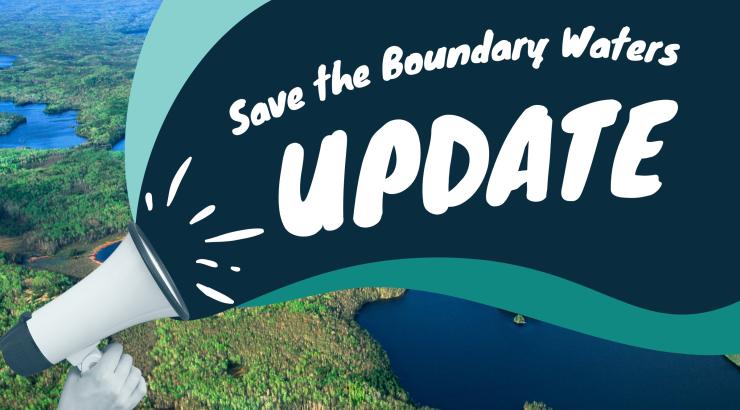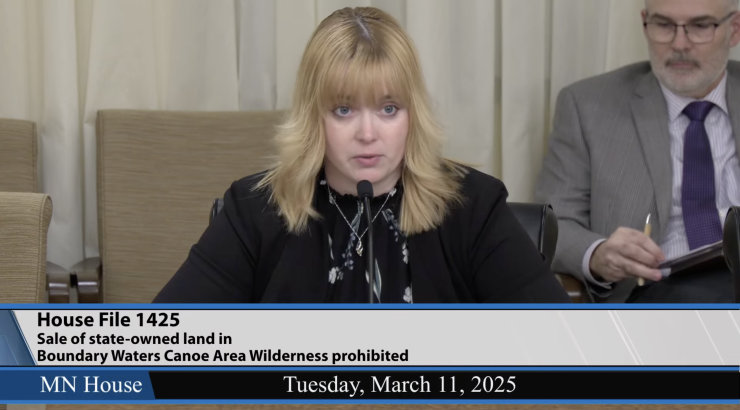Press Release
Department of the Interior Issues Public Land Order Protecting the Boundary Waters Canoe Area Wilderness from sulfide-ore mining
The order, called a mineral withdrawal, bans mining on public land next to the Wilderness. Minnesotans overwhelmingly support protection for the Boundary Waters and reject the false choice between "critical" minerals and protecting America's most visited Wilderness
(Ely, MN)-- Today Interior Secretary Deb Haaland signed a Public Land Order (PLO) protecting the Boundary Waters Canoe Area Wilderness (BWCAW or Wilderness), Voyageurs National Park (VNP), and 1854 Treaty Area from sulfide-ore copper mining. The PLO, called a mineral withdrawal, bans toxic mining on 225,504 acres of Superior National Forest land in the watershed of the BWCAW and upstream of the Wilderness. The PLO comes after the Forest Service published a comprehensive scientific review finding that sulfide-ore copper mining would pollute the Boundary Waters in ways that could not be fixed or mitigated. The PLO and the final Environmental Assessment (EA) are expected to be released tomorrow.
"Today's science-based decision is a massive win for Boundary Waters protection," said Becky Rom, National Chair of the Campaign to Save the Boundary Waters. "You don't allow America's most toxic industry next to America’s most popular Wilderness. The Boundary Waters is a paradise of woods and water. It is an ecological marvel, a world-class outdoor destination, and an economic engine for hundreds of businesses and many thousands of people. This decision moves America ever closer to permanently protecting this beloved Wilderness."
The draft EA explains that the purpose of the proposed 20-year mining ban is to protect and
preserve the natural and cultural resources in the watershed, including the Boundary Waters, the adjoining Mining Protection Area, and the 1854 Ceded Territory, from the known and potentially adverse environmental impacts arising from the exploration and development of federally owned minerals. In particular, the ban was deemed necessary to protect and preserve the unique water quality, scenic integrity, important wildlife corridors, and high-quality recreation values found in the watershed. The draft EA further elaborates on how the Boundary Waters’ complex and interconnected ecosystem offers recreational opportunities and other uses, which make it an irreplaceable national treasure that would be at severe risk from sulfide-ore copper mining without the mineral withdrawal.
In January 2022, the federal mineral leases for Chilean mining giant Antofagasta's Twin Metals project were revoked by the Department of Interior (DOI). DOI concluded that the leases had been unlawfully renewed by the Trump administration. There are currently no active mineral leases on federal land in the withdrawal area. Under the PLO announced today, none can be issued for twenty years.
The state of Minnesota is currently conducting its own review of whether sulfide-ore copper mining should be allowed in the Rainy River Headwaters. Northeastern Minnesotans for Wilderness (NMW) sued the Minnesota Department of Natural Resources (DNR) alleging the state's current rules were inadequate to protect the BWCAW as is legally required. The DNR is currently evaluating these rules, and a decision is expected before May 31, 2023. If the DNR finds the rules to be inadequate, then an administrative process will be conducted to amend the rules so that they adequately protect the Boundary Waters. There is also pending legislation to permanently protect the BWCAW at the state level.
Nearly 70 percent of Minnesotans support permanent protection for this priceless Wilderness area, and a vast collection of peer-reviewed science shows that if a Twin Metals mine was built along the rivers and streams flowing into the Wilderness, pollution and environmental degradation would be certain. A peer-reviewed independent study from Harvard University shows that protecting the Boundary Waters from proposed sulfide-ore mining would result in dramatically more jobs and more income over a 20-year period.
A 2017 report by the Minnesota Pollution Control Agency describes the waters within the mineral withdrawal area as “immaculate." The Report concludes that "the majority of the waterbodies within this watershed had exceptional biological, chemical, and physical characteristics that are worthy of additional protection."



